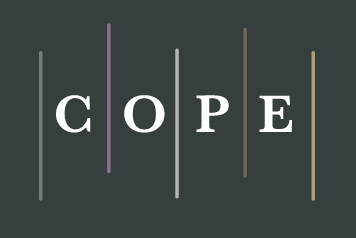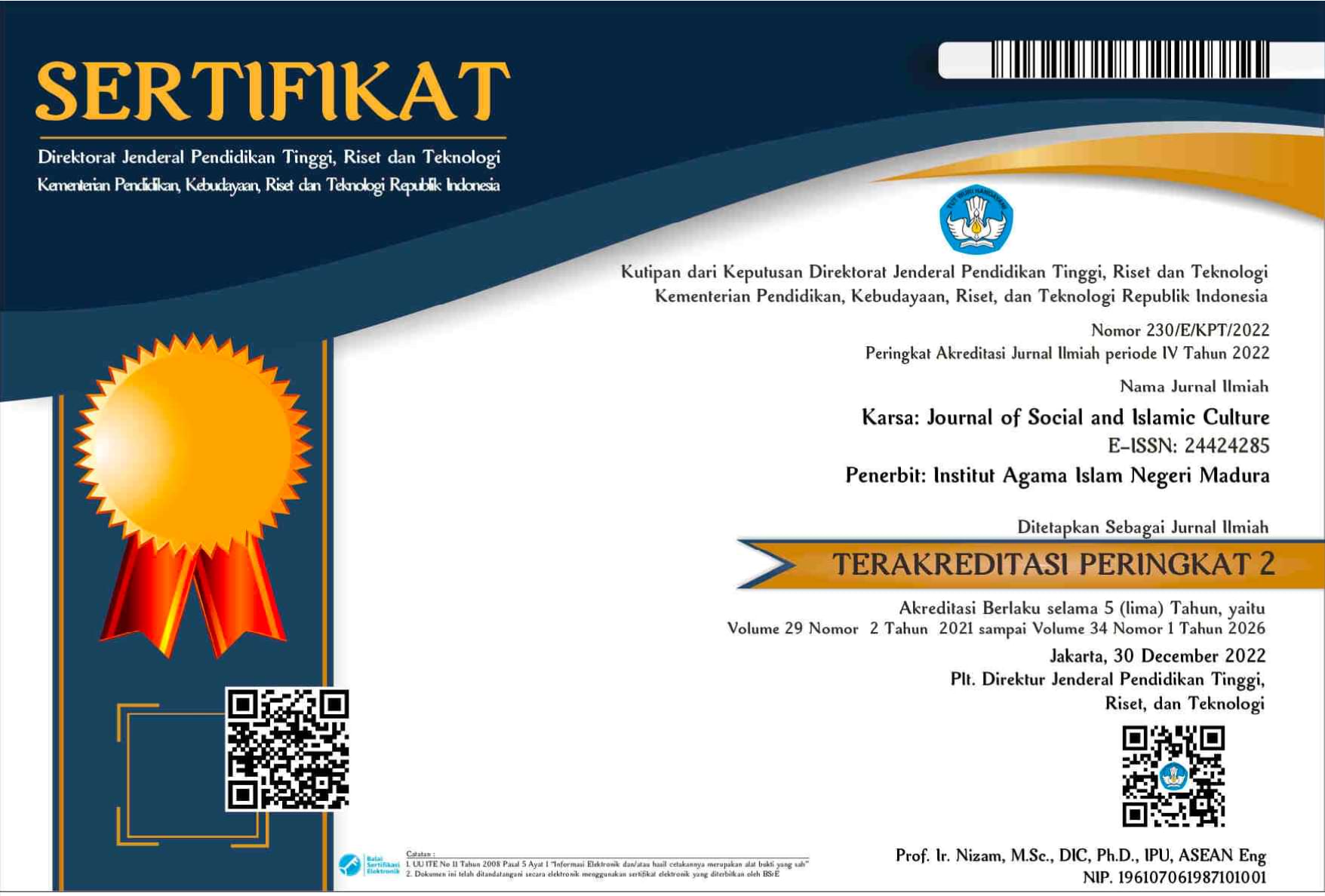PEREMPUAN SENI TRADISI DAN PENGEMBANGAN MODEL INDUSTRI KREATIF BERBASIS SENI PERTUNJUKAN
 Abstract views: 956
,
Abstract views: 956
,
 PDF downloads: 603
PDF downloads: 603
 OMPROK: PEREMPUAN SENI TRADISI DAN PENGEMBANGAN MODEL INDUSTRI KREATIF BERBASIS SENI PERTUNJUKAN downloads: 0
OMPROK: PEREMPUAN SENI TRADISI DAN PENGEMBANGAN MODEL INDUSTRI KREATIF BERBASIS SENI PERTUNJUKAN downloads: 0
Abstract
The absence of government policy in supporting the creative industry practice is a factor inhibiting the development of performing arts in Banyuwangi. Diverse local performing arts which if managed properly can become a crutch for the emergence of creative economy. This study aims at describing the struggles of women in the tradition arts and in conceptualizing a creative industry model ba-sed on performing arts. The study employed ethnography. The field data were obtained through interviews with the informants. The interpretation of data used a combination of tradition arts, gender, cultural studies, and creative industry perspectives. The results showed that women of tradition arts in general do not rely their livelihoods on art activitiy. They keep trying to develop creative know-ledge embodied in art creation and innovations. Arts institutions have a develop-ment program to maintain quality. The role of the government is manifested in the forms of policies, facilities, activity forums and infrastructural development. The development of Banyuwangi-style performing arts within the framework of the creative industry can support the realization of the creative economy.
Copyright (c) 2015 by KARSA. All right reserved
Downloads
References
Abidah, Farah. ‘JFC: Pencarian Identitas dan Perlawanan Subkultur’. SRIN-THIL, Edisi 11 (Mei 2011), hlm. 114.
Acciaioli, Greg. ‘Culture as Art: From Practice to Spectacle in Indonesia’. Canberra Anthropology, Vol. 8, No. 1-2 (1986).
Acker, Joan. ‘Inequality Regimes: Gender, Class, and Race in Organizations’ Gender and Society, Vol. 20, No. 4. (2006).
Anoegrajekti, Novi., Agus Sariono, dan Sunarti Mustamar. “Kesetaraan Jen-der dalam Perempuan Seni Tradisi.” Laporan Penelitian Strategis Nasional DP2M-DIKTI. Jember: Lembaga Pe-nelitian Universitas Jember, 2009.
Anoegrajekti, Novi. “Kesenian Using: Resistensi Budaya Komunitas Ping-gir,” dalam Kebijakan Kebudayaan di Masa Orde Baru. Jakarta: LIPI-Ford Foundation, 2001.
----. “Gandrung Banyuwangi: Pertaru-ngan Pasar, Tradisi, dan Agama Memperebutkan Representasi Iden-titas Using.” Disertasi Doktor: Fa-kultas Ilmu Pengetahuan Budaya Universitas Indonesia, 2006.
-----. Identitas Gender: Kontestasi Perempuan Seni Tradisi. Jember: Kompyawisda Jatim, 2010.
-----. “Kesenian Gandrung dan Identitas Using: Komodifikasi dan Politik Ke-budayaan.” Laporan Penelitian Funda-mental. Jember: Lembaga Penelitian Universitas Jember, 2011.
Barker, Chris. Making Sense of Cultural Studies: Central Problems and Critical Debates. London: Sage Publications, 2002.
-----. Cultural Studies, Teori dan Praktik. Yogyakarta: Kreasi Wacana, 2004.
Carlson, Marvin. “Performance: A Critical Introduction” dalam Performance and Cultural Politics. Ed. Diamongd, Elin. London: Routledge, 1996.
Hall, Gary & Clare Birchall (eds). New Cultural Studies: Adventures in Theo-ry. Edinburgh: Edinburgh Univer-sity Press, 2006.
Hall, Stuart. “The Work of Representa-tion.” Stuart Hall. Representation, Cultural Representation and Signifying Practices. London: Sage Publication in Association with The Open Uni-versity, 1997.
Hartley, John. “From the Consciousness Industry to Creative Industries: Consumer-Created Content, Social Network Markets, and the Growth of Knowledge” dalam Media Indus-tries: History, Theory and Methods. Eds. Jennifer Holt & Alisa Perren. Oxford: Blackwell, 2008.
Hesmondhalgh, David. The Cultural In-dustries. London and Thousand Oaks, CA: Sage Publications, 2007.
Murgiyanto, Sal, M. dan Munardi, A.M. Seblang dan Gandrung: Dua Bentuk Tari Tradisi di Banyuwangi. Jakarta: Pembinaan Media Kebudayaan, 1990.
Potts, Jason & Stuart Cunningham. “Four Models of The Creative Industries.” International Journal of Cultural Policy (2008).
Puspito, Peni. “Damarwulan Seni Per-tunjukan Rakyat di Kabupaten Ba-nyuwangi di Akhir Abad Ke-20.” Tesis Magister: Universitas Gadjah Mada, 1998.
Richardson, Diane. ‘Locating Sexualities: From Here to Normality’. Jurnal Sexualities, Vol. 7 (4), (2004).
-----. ‘Patterned Fluidities: (Re) Imagining the Relationship between Gender and Sexuality’. Sociology, Vol. 4, No. 3. (2007).
Risman, Barbara J. ‘Gender as Social Structure, Theory Wrestling with Activism’. Gender and Society, Vol. 18, No. 4. (Agustus, 2004)
Santoro, Marco. ‘Culture As (And After) Production’. Cultural Sociology. Vol. 2 (1): 7–31 (2008).
Sariono, Agus, Ikwan Setiawan, Andang Baharianto, Heru SP Saputra. “Ran-cak Tradisi dalam Gerak Industri: Pemberdayaan Kesenian Tradisi-Lo-kal dalam Perspektif Industri Krea-tif.” Laporan Penelitian Strategis Na-sional DP2M-DIKTI. Jember: Lemba-ga Penelitian Universitas Jember, 2009.
Setiawan, Ikwan. ‘Transformasi Masa La-lu dalam Nyanyian Masa Kini: Hib-ridasi dan Negosiasi Lokalitas da-lam Musik Populer Using’. Jurnal Kultur,Vol. 1, No. 2. (September 2007)
Setiawan, Ikwan. “Playing in-Between Space: Global Culture, Hibridity, and Strategic Contestation of Local Cul-tures.” Makalah dalam Seminar Nasional Bahasa dan Sastra Men-jembatani Budaya Lokal dan Global. Universitas Brawijaya, Desember, 2008.
Setiawan, Ikwan. ‘Contesting the Global: Global Culture, Hybridity, and Stra-tegic Contestation of Local-Tradi-tioanl Cultures’. Bulak, Jurnal Sosial dan Budaya, Vol. 4 (Mei 2009).
Spradley, James P. Metode Etnografi. Yogyakarta: Tiara Wacana, 1997.
Tomic-Koludrovic, Inga & Mirko Petric. “Creative Industries in Transition: Toward a Creative Economy” dalam The Emerging of Creative Industries in Southeastern Europe. Ed. Nada Svob-Dokic. Zagreb: Institute for Interna-tional Relations, 2005.
Walby, Sylvia. ‘Theorising Patriar-chy’. Sociology, Vol. 23 No. 2 (Mei 1989).
Wolbers, Paul, A. Maintaining Using Identity Through Musical Performace: Seblang and Gandrung of Banyuwangi, East Java, Indonesia. Urbana: Illinois, 1992.
Wolbers, Paul, A. “ The Seblang and its Music: Aspect of an East Javanese Fertility rite,” dalam Performance in Java and Bali: Studies of Narrative, Theatre, Music, and Dance. Ed. Bernard Arps. London: University of London, 1993.
The journal operates an Open Access policy under a Creative Commons Non-Commercial Share-Alike license. Authors who publish with this journal agree to the following terms:
- Authors retain copyright and grant the journal right of first publication with the work simultaneously licensed under a Creative Commons Attribution License that allows others to share the work with an acknowledgement of the work's authorship and initial publication in this journal.
- Authors are able to enter into separate, additional contractual arrangements for the non-exclusive distribution of the journal's published version of the work (e.g., post it to an institutional repository or publish it in a book), with an acknowledgement of its initial publication in this journal.
- Authors are permitted and encouraged to post their work online (e.g., in institutional repositories or on their website) prior to and during the submission process, as it can lead to productive exchanges, as well as earlier and greater citation of published work.





















